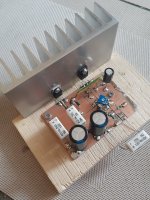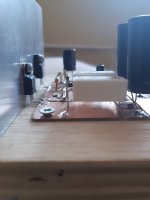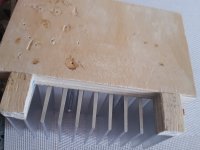The LM317 could offer some advantage over the more well-known modulated current source option implemented with a mosfet and a small bipolar transistor. I believe that the most obvious advantage could be in a better thermal control of the static polarization parameters, which could even allow a direct coupling of the output, if other conditions are ensured simultaneously.
Diego
Diego
The optocoupler bias control in the J2 is very stable.
The 3-pin regulator is just simpler, even with cascode.
Patrick
The 3-pin regulator is just simpler, even with cascode.
Patrick
I never looked into what output decoupling cap to use.
But for 8 ohm load, a 10000uF will give you -3dB at 2Hz, so minimum really.
Mouser still has some Nichicon LS, though already End of Life, like all audio components.
LKS1J103MESC
And then maybe a 100uF film cap in parallel for 200Hz upwards ?
Cheapest I can find is at DK :
B32778Z4107K000
Them together will set you back ~25€ per channel.
Probably more than all other components combined, if you do your own matching.
Not counting power supply, of course.
Patrick
But for 8 ohm load, a 10000uF will give you -3dB at 2Hz, so minimum really.
Mouser still has some Nichicon LS, though already End of Life, like all audio components.
LKS1J103MESC
And then maybe a 100uF film cap in parallel for 200Hz upwards ?
Cheapest I can find is at DK :
B32778Z4107K000
Them together will set you back ~25€ per channel.
Probably more than all other components combined, if you do your own matching.
Not counting power supply, of course.
Patrick
Last edited:
@TungstenAudioThis neat little amp looks like it would also work well with the IRFP048, a close descendant of the IRF044 as used in the original Zen amps.
I'm using the IRFP048 to test some new PCBs for the F6. It has characteristics close to my preferred, but nearly unobtanium FQH44N10.
Are the FQH44N10 worth buying instead of the IRFP048 ? If so, maybe we could do a GB.
Rochester has 9000 in stock but the minimum purchase is 187 mosfet…all of these for $250. I also found an American seller on eBay in case they are worth buying.
Disclaimer: Never heard of Rochester before.
BTW, the DIYaudio store currently sells Matched IRFP048 (look for F-6 Transistor kit)
Eric
All these high transconductance MOSFETs, including the IRFP044 mentioned before, have high Ciss.
That means to drive them in common source to a decent bandwidth requires low value resistors in the feedback network.
See Diego's post #45.
Unless of course you cascode, like in the Zen Variation 9.
Then you can go back to more common power-amp Zin of ~10k.
Penalty ? Needs higher voltage.
No free lunch.
Patrick
That means to drive them in common source to a decent bandwidth requires low value resistors in the feedback network.
See Diego's post #45.
Unless of course you cascode, like in the Zen Variation 9.
Then you can go back to more common power-amp Zin of ~10k.
Penalty ? Needs higher voltage.
No free lunch.
Patrick
Last edited:
The FQH44N10 has characteristics that work very well in several applications. I have used it where the amp is running on higher voltage rails, and at higher bias current. This part has been found to sound better in the ACA vs the IRFP240 or IRFP140 by several builders. It slays in my F6, giving it a sonic character nearly identical to my re-capped Threshold CAS-2.
Of the higher transconductance Mosfets, its gate capacitance, Ciss, and total gate charge are remarkably low, better than the IRFP140. I adjust the amp circuit by using somewhat smaller gate stopper resistors.
I bought a tube of 30pcs from the ebay seller with that picture. They appear to be genuine NOS from Fairchild. My previous parts were from OnSemi, so I can’t directly compare the marking, but the F logo looks correct. I will be using the Fairchild parts in my new F6 Diamond PCBs, and will have a direct sonic comparison then.
Of the higher transconductance Mosfets, its gate capacitance, Ciss, and total gate charge are remarkably low, better than the IRFP140. I adjust the amp circuit by using somewhat smaller gate stopper resistors.
I bought a tube of 30pcs from the ebay seller with that picture. They appear to be genuine NOS from Fairchild. My previous parts were from OnSemi, so I can’t directly compare the marking, but the F logo looks correct. I will be using the Fairchild parts in my new F6 Diamond PCBs, and will have a direct sonic comparison then.
Another one, still can be ordered from Mouser (Feb 2024) :
https://eu.mouser.com/ProductDetail/onsemi-Fairchild/FQA28N15?qs=mdiO5HdF0Ki20kP2bhAtZg==
Only end of life, not obsolete.
Patrick
https://eu.mouser.com/ProductDetail/onsemi-Fairchild/FQA28N15?qs=mdiO5HdF0Ki20kP2bhAtZg==
Only end of life, not obsolete.
Patrick
HiI have been working to convert the mythical Nelson Pass amplifier into a simpler one, with the addition of the well-known LM317 voltage regulator, in a curious way of operation. The result is surprisingly good.
Only 9 components, not counting those of the power supply.
Did anyone get a chance to build this amp besides Diego ?
Thanks
Hi, yes, I built it. It works flawlessly, natural sound. Many thanks Diego for your design.
Hi,
I used IRFP044 instead of Diego's IRFP150, and because I've used a low output portable CD player as a source, I increased feedback resistor R5 to 6.6K from 2.2K. I mention I use a laptop smps which outputs 20.4V, and 5Watt resistors R2=1ohm and R1=1.2ohm. If it's possible, Diego, please help me: how my feedback resistor change (giving larger voltage gain) impact THD ?
Many thanks !
I used IRFP044 instead of Diego's IRFP150, and because I've used a low output portable CD player as a source, I increased feedback resistor R5 to 6.6K from 2.2K. I mention I use a laptop smps which outputs 20.4V, and 5Watt resistors R2=1ohm and R1=1.2ohm. If it's possible, Diego, please help me: how my feedback resistor change (giving larger voltage gain) impact THD ?
Many thanks !
I'm going to make some PCBs at the factory. You've got me curious...
Is anyone interested?
Is anyone interested?
- Home
- Amplifiers
- Pass Labs
- Hybrid ZEN Amplifier + LM317 = Efficient and simple



